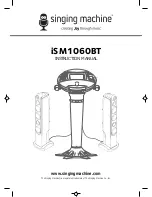
6
has started. Do not weld or cut in
atmospheres containing
h. Dangerously
reactive
or
flammable gases, vapors, liquids,
and dust.
i. Provide adequate ventilation in
work
areas
to
prevent
accumulation of flammable gases,
vapors, and dust. Do not apply
heat to a container that has held
an unknown substance or a
combustible
material
whose
contents, when heated, can
produce flammable or explosive
vapors.
Clean
and
purge
containers before applying heat.
Vent closed containers, including
castings,
before
preheating,
welding, or cutting.
j. Only use compressed air to
operate the Plasma Welder/Cutter.
Never use other compressed
gases.
9. Avoid overexposure to fumes and
gases. Always keep your head out of
the fumes. Do not breathe the fumes.
Use enough ventilation or exhaust, or
both, to keep fumes and gases from
your breathing zone and general area.
!
Where ventilation is questionable,
have a qualified technician take
an air sampling to determine the
need for corrective measures.
Use mechanical ventilation to
improve air quality. If engineering
controls are not feasible, use an
approved respirator.
!
Work in a confined area only if it
is well ventilated, or while
wearing
an
air-supplied
respirator.
!
Follow OSHA guidelines for
Permissible
Exposure
Limits
(PEL’s) for various fumes and
gases.
!
Follow the American Conference
of
Governmental
Industrial
Hygienists recommendations for
Threshold Limit Values (TLV’s)
for fumes and gases.
!
Have a recognized specialist in
Industrial
Hygiene
or
Environmental Services check
the operation and air quality and
make recommendations for the
specific
welding
or
cutting
situation.
10.
Always keep hoses away from
welding/cutting spot.
Examine all
hoses and cables for cuts, burns, or
worn areas before each use. If any
damaged areas are found, replace the
hoses or cables immediately.
11.
Read and understand all
instructions and safety precautions
WARNING
INHALATION HAZARD: Welding and Plasma
Cutting Produce
TOXIC FUMES.
Exposure to welding or cutting exhaust fumes can
increase the risk of developing certain cancers, such as
cancer of the larynx and lung cancer. Also, some
diseases that may be linked to exposure to welding or
plasma cutting exhaust fumes are:
a. Early onset of Parkinson’s Disease
b. Heart disease
c. Ulcers
d. Damage to the reproductive organs
e. Inflammation of the small intestine or stomach
f.
Kidney damage
g. Respiratory diseases such as emphysema,
bronchitis, or pneumonia
Use natural or forced air ventilation and wear a respirator
approved by NIOSH to protect against the fumes
produced to reduce the risk of
developing the above
illnesses.
Содержание 597078
Страница 1: ...1 ...
Страница 16: ...16 ASSEMBLY STRUCTURE ...
Страница 18: ...18 Wiring Diagram ...
Страница 20: ...20 ...






































